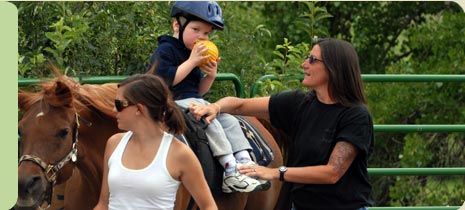Front Range Hippotherapy
Hippotherapy Physical Therapy Services in the Boulder/Longmont Area
Hippotherapy can be a valuable physical therapy tool for individuals with mental and physical disabilities. Our physical therapist has over 18 years of experience and we own and operate our family-friendly facility in Longmont, Colorado.
Sessions usually last between 30-45 minutes, with 30 minutes mounted. We have sessions year-round — and in inclement weather we treat indoors with special equipment designed to enhance the client’s experience on the horse.
Hippotherapy Session Availability:
- Monday-Saturday 8am-5pm (please call for availability)
Schedule an appointment today>>
We feel strongly that hippotherapy is not exclusive as a tool and are very happy to incorporate traditional methods of stretching, therapeutic exercise, gait and mobility training, balance and coordination training and sensory integration techniques into our equine physical therapy practice.
Read More About Hippotherapy Here
Hippotherapy and Autism
Hippotherapy and Autism: Clients with autism typically experience deficits in language, sensory processing and reading social cues. Being on a horse can address many of these limitations. The horse’s three-dimensional movement provides sensory stimulation to muscles and joints (called proprioception), impacts the balance and movement sense detected by sensory receptors in the inner ear (called the vestibular system), and provides varied tactile (touch) experiences when the client rubs or pats or hugs the horse, feels the heat from the horse’s body and feels the effects of the natural environment (sun/wind).
Learn More About How Hippotherapy and Autism
Hippotherapy and Cerebral Palsy
In hippotherapy, a trained physical therapist, usually with a team of horse handler and sidewalker, walks alongside the patient, providing support as needed. The therapist may place the patient in a variety of positions on the horse, such as sideways and backwards, and have her reach for toys or other items.
The therapist has a trained view of horse movement and knows when to ask the horse for an upward transition ( halt—walk;walk-trot or walk—fast walk) or a downward transition (trot—walk; fast walk –walk or walk-halt).
The idea behind hippotherapy is that the rhythmic movement of the horse provides a sense of rhythm to the patient with cerebral palsy, and through developing and normalizing muscle tone in the trunk and extremities, encourages the patient to align his head, torso and hips correctly, which aids in sitting, and eventually standing and walking.
Learn More About How Hippotherapy Helps Cerebral Palsy Clients
Down Syndrome and Hippotherapy
Clients are taught to relate appropriately to the horse with gentle rubs. Hitting and higher graded movements are discouraged, thereby assisting with a clients judgment and awareness of his/her body as it relates to others on the team—most importantly, the horse. The consequences of inappropriate behaviors are easy to implement. The horse stops.
Good behavior is rewarded in a variety of ways. It may include short trots, fun games, or rewards after the session is over such as giving the horse a treat. Higher functioning clients learn how to engage their team in goal-directed conversations as they move through complex warm up exercises or how to perform advanced positions such as kneeling or standing on the horse. These activities develop memory, strength and coordination, instill self-confidence in the client and they are a lot of fun.
Learn More About Hippotherapy and Down Syndrome
